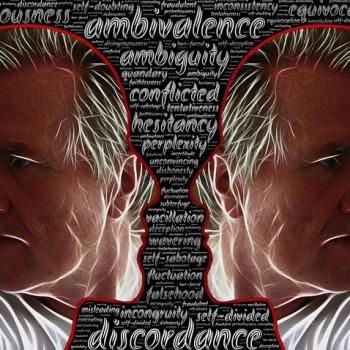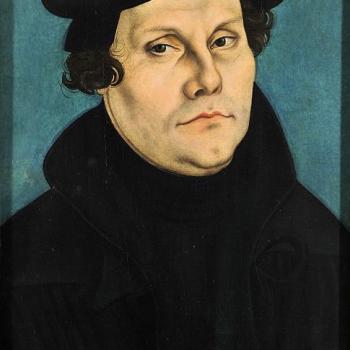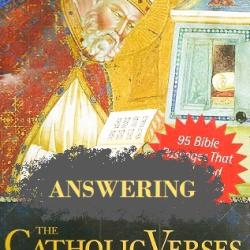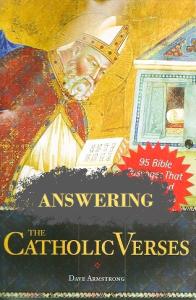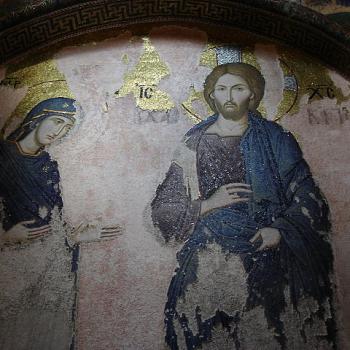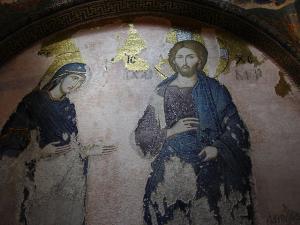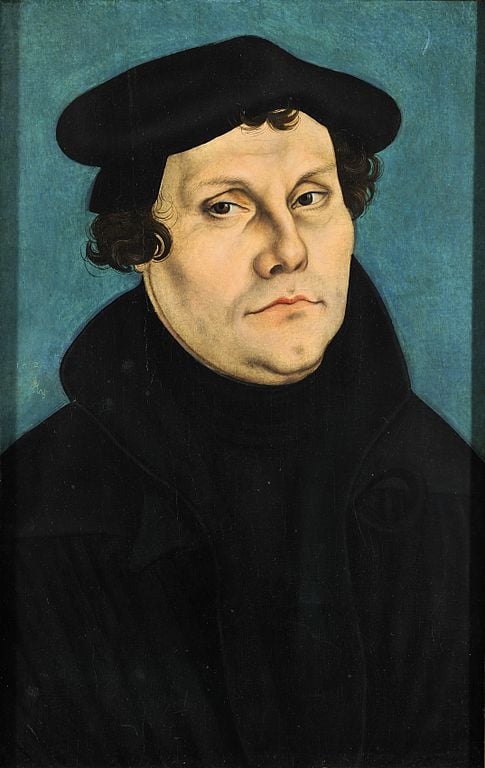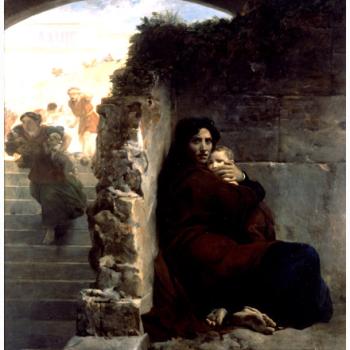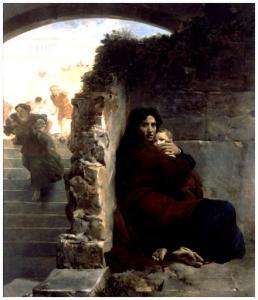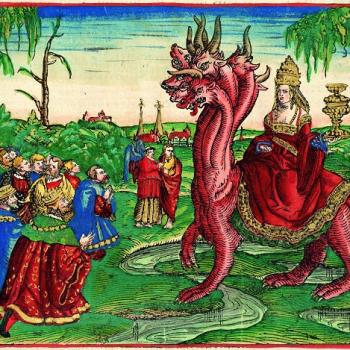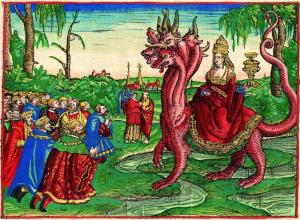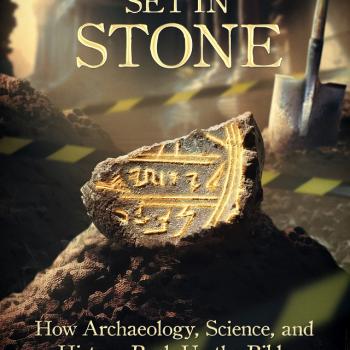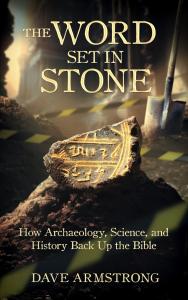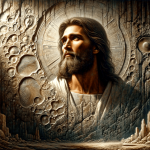. . . Particularly the Immaculate Conception / Has Present-Day Protestantism Maintained the Classical “Reformational” Heritage of Mariology?
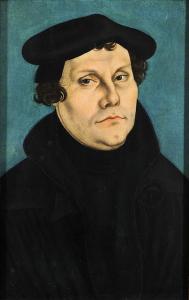
This is a slightly abridged and revised version of the original lengthy reply in three parts (one / two / three) from 26 April 2003; answering the anti-Catholic Reformed Protestant Luther defender James Swan‘s article, “Martin Luther’s Theology of Mary.” His words will be in blue; Martin Luther’s in green. Two sections of the original (one / two) were organized into separate papers.
Brand-new portions will be bracketed. In some ways, my understanding of Luther’s Mariology has grown through the almost twenty years since the original exchange, including one fairly significant change of opinion. The original can still be read above, as long as it is available on Internet Archive. See also the “de-Swanned” version, with just my own words.
*****
TABLE OF CONTENTS
I. Overview of Catholic and Protestant Treatments of Luther’s Mariology
II. Have Catholic Apologists Exaggerated the Mariology of Luther and Other Early Protestant Leaders?
III. Lutheran Scholar Arthur Carl Piepkorn & Luther’s “Life-Long” Belief in the Immaculate Conception
IV. The Mariology of the Lutheran Confessions
V. Did Luther “Minimize” or Reject Various Aspects of Traditional Mariology in His Later Years?
VI. Immaculate Conception, Part One: The Fathers and Mary’s Sinlessness
VII. Immaculate Conception, Part Two: Theological Misunderstandings
VIII. Immaculate Conception, Part Three: Scholarly Opinion Concerning Luther’s Beliefs
IX. Concluding Thoughts
*****
I. Overview of Catholic and Protestant Treatments of Luther’s Mariology
A quick search for information about Martin Luther on the World Wide Web reveals that polemics against Luther remain frequent and high-pitched, as different groups create the villain they find in his writings. The basic elements of Luther’s thought are generally missing, distorting the man, his theology, and his impact upon post-Reformation society.
Sketches of Luther from Roman Catholic perspectives bring forth numerous images. Some cling to presenting Luther as Cochlaeus did five hundred years ago, as a “a child of the devil”, a liar and a hypocrite, cowardly and quarrelsome. [Joseph Lortz, The Reformation in Germany, trans. Ronald Walls (London: Darton, Longman & Todd, 1968), 1:296. Lortz does not give the reference to his quote of Cochlaeus] Others present a more “Catholic” Luther, one of whom contemporary Protestants allegedly suppress to maintain doctrinal hostility to Rome. Such is the case with Luther’s theology of Mary. One Roman Catholic [myself] paints the Reformer as being a devotee to the Blessed Virgin:
Luther indeed was quite devoted to Our Lady, and retained most of the traditional Marian doctrines which were held then and now by the Catholic Church. This is often not well documented in Protestant biographies of Luther and histories of the 16th century, yet it is undeniably true. It seems to be a natural human tendency for latter-day followers to project back onto the founder of a movement their own prevailing viewpoints. Since Lutheranism today does not possess a very robust Mariology, it is usually assumed that Luther himself had similar opinions. We shall see, upon consulting the primary sources (i.e., Luther’s own writings), that the historical facts are very different. [Dave Armstrong, “Martin Luther Was Extraordinarily Devoted to Mary”; 1994]
The author draws a picture of Luther espousing a doctrine of Mary that reflects Roman Catholic theology, with little or no conflict with his
Reformation ideals.
This is inaccurate. In the above paper, which is not all that long, I made several nuanced, qualifying remarks, contrasting Luther’s Marian views with those of the Catholic Church:
Probably the most astonishing Marian belief of Luther is his acceptance of Mary’s Immaculate Conception . . . Concerning this question there is some dispute, over the technical aspects of medieval theories of conception and the soul, and whether or not Luther later changed his mind. Even some eminent Lutheran scholars, however, such as Arthur Carl Piepkorn (1907-73) of Concordia Seminary in St. Louis, maintain his unswerving acceptance of the doctrine . . . In later life (he died in 1546), Luther did not believe that this doctrine should be imposed on all believers, since he felt that the Bible didn’t explicitly and formally teach it. Such a view is consistent with his notion of sola Scriptura and is similar to his opinion on the bodily Assumption of the Virgin, which he never denied – although he was highly critical of what he felt were excesses in the celebration of this Feast.
Luther did strongly condemn any devotional practices which implied that Mary was in any way equal to our Lord or that she took anything away from His sole sufficiency as our Savior. This is, and always has been, the official teaching of the Catholic Church. Unfortunately, Luther often “threw out the baby with the bath water,” when it came to criticizing erroneous emphases and opinions which were prevalent in his time – falsely equating them with Church doctrine. His attitude towards the use of the “Hail Mary” prayer (the first portion of the Rosary) is illustrative. In certain polemical utterances he appears to condemn its recitation altogether, but he is only forbidding a use of Marian devotions apart from heartfelt faith, . . .
To summarize, it is apparent that Luther was extraordinarily devoted to the Blessed Virgin Mary, which is notable in light of his aversion to so many other “Papist” or “Romish” doctrines, as he was wont to describe them. His major departure occurs with regard to the intercession and invocation of the saints, which he denied, in accord with the earliest systematic Lutheran creed, the Augsburg Confession of 1530 (Article 21). His views of Mary as Mother of God and as ever-Virgin were identical to those in Catholicism, and his opinions on the Immaculate Conception, Mary’s “Spiritual Motherhood” and the use of the “Hail Mary” were substantially the same. He didn’t deny the Assumption (he certainly didn’t hesitate to rail against doctrines he opposed!), and venerated Mary in a very touching fashion which, as far as it goes, is not at all contrary to Catholic piety. Therefore, it can be stated without fear of contradiction that Luther’s Mariology is very close to that of the Catholic Church today, far more than it is to the theology of modern-day Lutheranism.
It is pointed out that Luther used the venerating term, “Mother of God.” He also believed in her perpetual virginity, Immaculate Conception, and her “spiritual motherhood” of all Christians. He believed that prayers to her with “heartfelt faith” were allowed.
Insofar as demonstrated in the paper and elsewhere on my website, by citations, yes indeed. Historical facts are what they are; I didn’t make up Luther’s views on Mary.
Has the great reformer been done an injustice by his theological offspring? Have they neglected to follow his lead in venerating Mary as part of historic Protestantism? . . . By reading selected quotes [of] Luther, it does indeed appear that Protestantism has deviated from his veneration of Mary.
That is for Protestants themselves to decide (note that Mr. Swan — strangely — appears to even doubt the fact of such a change). I was merely presenting certain little-known facts about Luther’s Mariology. Of course the Catholic would contend that Luther was more biblical and traditional on this score (hence, more correct and “orthodox” from the historic Catholic standpoint) than virtually all present-day Lutherans.
As for Protestant “suppression” of Luther’s Mariology, I will cite just two examples from countless ones that could easily be brought forth. In the standard reference work, The Theology of Martin Luther, by Paul Althaus (tr. Robert C. Schultz, Philadelphia: Fortress Press, 1966), a work of 464 profusely-documented pages, no section on Mary appears at all, though there are sections on topics such as, for example, “The People of God,” “The Church as the Community of Saints,” “The Office of the Ministry,” etc., thus showing that the work is rather wide-ranging. Mary cannot even be found in the Index of Names. The closest it gets is “Virgin Birth, dogma of” (p. 464). The author writes in his preface:
My purpose in this book is . . . to present a comprehensive overview of the basic elements of Luther’s theological work . . .
It is my intention that this book systematically present and interpret Luther’s teaching.
Perhaps the key to the omission might be located in the following words:
Luther’s understanding of the gospel remains a vital reality in spite of everything in his theology which reflects the conditions of his times and which we cannot use. (Preface to German edition, v-vi)
It is neither my intention nor purpose to cast aspersions upon professor Althaus’s generally excellent and helpful research. My point is only that current-day Lutherans and Protestants in general emphasize Mariology far less than the “Protestant Reformers” did (Luther, perhaps, above all). I don’t see that this is even arguable. Whether one holds that this reality is a desirable or undesirable change (which is another question: one of theology, orthodoxy, creeds, and confessions), it exists nonetheless. To assert it as a rather obvious sociological fact (that is, obvious once one is a bit acquainted with the historical background of the development of Protestant thought) is not necessarily to take any particular position on the Mariological disputes in theology. Not all research on these issues has to have polemics and defense of one’s own particular position on theology or history as its motivation.
A similar situation can be found in Williston Walker’s book, John Calvin: The Organiser of Reformed Protestantism (New York: Schocken Books, 1969). In this comprehensive treatment of Calvin’s life and theology (nearly 500 pages), one discovers a single (rather casual) reference to Mary.
II. Have Catholic Apologists Exaggerated the Mariology of Luther and Other Early Protestant Leaders?
The eminent and respected Orthodox (formerly Lutheran) Church historian, Jaroslav Pelikan, wrote:
This approach to Luther is not new. In 1962 Roman Catholic author Walter Tappolet compiled an astonishing compilation of texts from Luther, Calvin, Zwingli, and Bullinger called, The Reformers in Praise of Mary. By going through sermons, devotional material and theological treatises, he documented an enduring orthodoxy of the Mariology of the Reformers. (Jaroslav Pelikan, Mary Through The Ages [New Haven: Yale University Press, 1996], 158, referencing Walter Tappolet, ed., Das Marienlob der Reformatoren [Tubingen: Katzman Verlag, 1962].)
In light of the context of his entire paper, it is clear that Mr. Swan is skeptical of such a description of early Protestant views; he does not accept it. He neglects to inform the reader, however, that Pelikan himself is not nearly so skeptical. I shall cite his statements from the same book. Mr. Pelikan noted the vigorous opposition of early Protestants to idolatry and excesses of the communion of saints — as I did, in my article above — (much of which was in full agreement with Catholic teaching, rightly-understood). But Pelikan maintains that that is not the entire picture of early Protestant Mariology:
[I]t would be a mistake, and one which many interpretations of the Reformation both friendly and hostile have all too easily fallen, to emphasize these negative and polemical aspects of its Mariology at the expense of the positive place the Protestant Reformers assigned to her in their theology. They repeated . . . the central content of the orthodox confession of the first five centuries of Christian history. (Pelikan, ibid., 157)
Pelikan’s opinions are echoed by evangelical David Wright:
[T]he Churches that look back to the Reformers have on the whole been less affirmative about Mary than most of the Reformers themselves. (Chosen by God: Mary in Evangelical Perspective, London: Marshall Pickering, 1989, 123)
Likewise, Catholic writer William J. Cole observes:
[Luther’s] custom of preaching Marian sermons on the Marian feasts continued in the Lutheran Church a hundred years after his death. Following the example of Luther other great songwriters of the Reformation glorified the greatness of Mary’s divine maternity. This lasting piety towards the Mother of God found an outlet in piety so that generally the celebrated pictures of the Madonna and her statues from the Middle Ages were retained in Lutheran churches. According to Heiler, it was only the spirit of the Enlightenment with its lack of understanding of the mystery of the Incarnation, which in the 18th century began the work of destruction. (“Was Luther a Devotee of Mary?,” Marian Studies, 21, 1970, 101-102)
[T]he Reformer preached more about Mary than Catholic priests do in this era of the Church’s history. (Ibid., 182)
The Catholic scholar Thomas A. O’Meara stated:
It was the times with their changes in intellectual and cultural outlook, it was the very history of the Reform with its forgetfulness of the fullness of its Lutheran and Calvinist inheritance, which caused a Christian religion to come into existence without any place for Christ’s Mother. We should remember that this was not the view of the Reformers, nor is it intrinsic to Protestantism. (Mary in Protestant and Catholic Thought, New York: Sheed & Ward, 1966, 137)
David Wright (who freely and vigorously criticizes various aspects of Catholic Mariology) applies the belief in Mary’s perpetual virginity to the early Protestant leaders generally, noting “the long-established universal belief in Mary’s perpetual virginity, which was endorsed by all the Reformers virtually without qualification ” (Wright, ibid., 169). Wright observes, furthermore, that “the English Reformers probably to a man shared [the] conviction of Mary’s perpetual virginity” (Ibid., 172).
He states that Hugh Latimer, Miles Coverdale, Robert Barnes, and Thomas Cranmer all accepted the doctrine of Mary’s perpetual virginity, and that Cranmer thought it was proven from Scripture. Hugh Latimer also strongly held to Mary’s immaculate conception (Wright, ibid., 174). Many, if not most Protestants today deny the perpetual virginity of Mary, but it was standard belief among the leaders of early Protestantism (and even later prominent figures such as John Wesley). See also, my paper: Perpetual Virginity of Mary: Held by All Protestant Reformers [1-27-02].
The famous Swiss Protestant theologian Karl Barth wrote:
As Christians and theologians, we do not reject the description of Mary as the “Mother of God,” but in spite of its being overloaded by the so-called Mariology of the Roman Catholic Church, we affirm and approve of it as a legitimate expression of Christological truth. . . . The description of Mary as the “Mother of God” was and is sensible, permissible and necessary as an auxiliary Christological proposition. (Church Dogmatics, I, 2, Edinburgh: T. & T. Clark, 1963, 138)
The Protestant Reformed scholar Max Thurian observed:
Whatever may be the position theologically that one may take today on the subject of Mariology, one is not able to call to one’s aid “reformed tradition” unless one does it with the greatest care . . . the Marian doctrine of the Reformers is consonant with the great tradition of the Church in all the essentials and with that of the Fathers of the first centuries in particular . . .
In regard to the Marian doctrine of the Reformers, we have already seen how unanimous they are in all that concerns Mary’s holiness and perpetual virginity. Whatever the theological position which we may hold today, in regard to the Immaculate Conception and Assumption of Mary it is right to know, perhaps to our great surprise, that these two Catholic dogmas were accepted by certain Reformers, not of course in their present form but certainly in the form that was current in their day. (Mary: Mother of all Christians, tr. Neville B. Cryer, New York: Herder & Herder, 1963, 77, 197)
The well-known Lutheran theologian Friedrich Heiler thought that the Marian doctrines were greatly minimized or abandoned by later Protestants because of “the spirit of the enlightenment with its lack of understanding of mystery, and especially of the mystery of the Incarnation, which in the 18th century began the work of destruction” ( “Die Gottesmutter im Glauben und Beten der Jahrhunderte,” Hochkirche 13 [1931], 200). Another Lutheran scholar, Basilea Schlink, believes that:
[T]he majority of us have drifted away from the proper attitude towards her, which Martin Luther had indicated to us on the basis of Holy Scripture … [partially due to the rise of Rationalism which] has lost the sense of the sacred. In Rationalism man sought to comprehend everything, and that which he could not comprehend he rejected. Because Rationalism accepted only that which could be explained rationally, Church festivals in honor of Mary and everything else reminiscent of her were done away with in the Protestant Church. All biblical relationship to the Mother Mary was lost, and we are still suffering from this heritage.
When Martin Luther bids us to praise the Mother Mary, declaring that she can never be praised enough as the noblest lady and, after Christ, the fairest gem in Christendom, I must confess that for many years I was one of those who had not done so, although Scripture says that henceforth all generations would call Mary blessed [Luke 1:48]. I had not taken my place among these generations. (Mary, the Mother of Jesus, London: Marshall Pickering, 1986, 114-115)
And the Anglican A. Lancashire states:
A rejection of Mariology must inevitably lead to a rejection of orthodox Christology. … Devotion to Mary, far from leading men away from Christ, draws the Church into a deeper recognition of the mystery of God’s loving activity directed towards man in Christ. (Born of the Virgin Mary, London: The Faith Press, 1962, 142-143)
To give the reader unacquainted with this line of inquiry a flavor of the robust early Protestant Marian piety, I will cite the words of one of the major Protestant “Reformers,” Heinrich Bullinger (1504-1575), successor to Zwingli and author of the Second Helvetic Confession:
In Mary everything is extraordinary and all the more glorious as it has sprung from pure faith and burning love of God. . . . the most unique and the noblest member of the Christian community . . . The Virgin Mary . . . completely sanctified by the grace and blood of her only Son and abundantly endowed by the gift of the Holy Spirit and preferred to all . . . now lives happily with Christ in heaven and is called and remains ever-Virgin and Mother of God. (in Hilda Graef, Mary: A History of Doctrine and Devotion, combined edition of volumes 1 & 2, London: Sheed & Ward, 1965, vol. 2, 14-15)
What pre-eminence in the eyes of God the Virgin Mary had on account of her piety, her faith, her purity, her saintliness and all her virtues, so that she can hardly be compared with any of the other saints, but should by rights be rather elevated above all of them, appears very clearly in the first chapters of the gospels of St. Matthew and St. Luke, and particularly in her Magnificat . . . If Mary really is the Mother of the Lord, . . . then it is altogether just that she should be named by the Fathers of the Church theotokos, that is to say Mother of God. Nestorius denied that in the most infamous manner . . . She . . . surpasses with distinction all women. (in Thurian, ibid., 89 / Uber die Selige Jungfrau, May 18, 1558)
Elijah was transported body and soul in a chariot of fire; he was not buried in any Church bearing his name, but mounted up to heaven, so that . . .we might know what immortality and recompense God prepares for his faithful prophets and for his most outstanding and incomparable creatures . . . It is for this reason, we believe, that the pure and immaculate embodiment of the Mother of God, the Virgin Mary, the Temple of the Holy Spirit, that is to say her saintly body, was carried up to heaven by the angels. (in Thurian, ibid., 197-198 / De origine erroris, 16, written in 1568)
Zurich during Zwingli’s tenure continued to observe the Feast of the Assumption on August 15th (Acts of the Council in March 1526 and March 1530; see Thurian, ibid., p. 186).
Protestant author Peter Toon offers a strikingly wistful reflection:
I must confess that I am deeply impressed by the way in which some of my favorite writers — Bernard, Francis de Sales, Anselm, and moderns like Hans Urs von Balthasar — have both a profound love for our Lord and a special love for Mary. Take for example this extract from a prayer of Anselm: “Surely Jesus, Son of God, and Mary His Mother, you both want, and it is only right, that whatever you love, we should love too. So, good Son, I ask you through the love you have for your Mother, that as she truly loves you and you her, you will grant that I may truly love her. Good Mother, I ask you by the love you have for your Son, that, as He truly loves you and you Him, you will grant that I may love Him truly.” . . . I ask myself: Why cannot I pray in this manner? Is there something lacking in my theological and spiritual appreciation that prevents me from regarding Mary in this way? And as yet I have found no satisfactory answers to my questions . . . In the joyful celebration of Mary, we hear, confess and believe the truth that God has taken the initiative for our salvation. Mary is a continuing witness to the divine initiative. She expressed sola gratia, ‘by grace alone’, in a dynamic and compelling way. (“Appreciating Mary Today,” in Chosen by God: Mary in Evangelical Perspective, edited by David F. Wright, London: Marshall Pickering, 1989, 225-226)
Elliot Miller, of the evangelical Christian Research Institute (founded by the eminent cult researcher, the late Dr. Walter Martin), confesses:
[I]t is regrettably true that some Protestants — no doubt in reaction to Catholic excesses — have almost forgotten Mary. This is no more the will of God than it would be for Christians to ignore Moses, John the Baptist, or the apostles Paul, Peter, and John. . . . In other words, while Mary is not exalted above every other created being in the Bible, she is one of the most important figures found in it. ‘Blessed among women,’ she is the preeminent feminine model of faith and obedience; worthy of honor and admiration. (“The Mary of Roman Catholicism,” Christian Research Journal, Summer 1990: 9-15; Fall 1990: 27-33; quote from p. 33)
Evangelical Protestant John De Satge makes a remarkable statement on Mary from a Protestant perspective:
[A] proper relationship with our Lord’s Mother safeguards the conditions essential for evangelical religion, the heart of which is to know Christ as your Savior . . . If evangelical religion is not to be merely metaphor or sentiment or coziness, it must say things about the Savior which mean that though He is fully human and our Brother, He is a great deal more besides. And those are the very things that lead us to call His Mother the Mother of God. The things which Catholics say about Mary safeguard the things which Evangelicals say about her Son . . . Proper Marian devotion, on the contrary, opens up further reaches of experience to the searching and the succor of the Gospel . . . Once the Catholic Church has reordered its house, the time for protest is past and the evangelical should go home as soon as may be. I believe that, in Marian matters at least, that point has been reached. The task before those who believe as I do is to help our fellow-heirs of the Reformation appreciate that which they had previously denied . . . It seems to me that our Lady stands in the life of her Son’s people as a gracious hostess, making one free of large rooms which hitherto had been closed or dark and forbidding. She is supremely fitted to do this, being wholly one of us and wholly yielded to God, the Mother of God who through grace is the daughter of her Son. May evangelicals who rejoice in her Son’s Gospel take their proper share in calling her “blessed,” who accepted so fully that grace by which they live. (“The Evangelical Mary,” in Mary’s Place in Christian Dialogue, edited by Alberic Stacpoole, Slough, England: St. Paul Publications, 1982, 25-33)
Thomas Howard writes about Mary eloquently, from a Catholic perspective (this was written in the year before he was received into the Church, as an Anglican):
A parsimonious notion of God’s glory has been one result of the revulsion felt by so many over the honour paid to Mary, as though to say, If God alone is all-glorious, then no one else is glorious at all. No exaltation may be admitted for any other creature, since this would endanger the exclusive prerogative of God.
But this is to imagine a paltry court. What king surrounds himself with warped, dwarfish, worthless creatures? The more glorious the king, the more glorious are the titles and honors he bestows . . . He is a very great king, to have figures of such immense dignity in his train, or even better, to have raised them to such dignity. These great lords and ladies, mantled and crowned with the highest possible honor and rank are, precisely, his vassals. This glittering array is his court! All glory to him and, in him, glory and honor to these others.
We know all this from reading about the courts of great kings in our own history. We also know it of God, who is attended by creatures of such burning splendor that we can scarcely imagine them: angels, archangels, virtues, thrones, dominations, princedoms, powers, and then the terrible cherubim, and finally the seraphim themselves . . .
There is one whose dignity is shared by no other. She is a woman, the humblest of them all. No empress, prophetess, or conqueror she, only the handmaid of the Lord. But in her exaltation we see the divine magnanimity, which has regarded the lowliness of His handmaiden and has exalted the humble and meek . . . ‘Magnificat!’ she sings, and ‘Hail!’ we answer, in the joyful courtesies of heaven.
The Christian piety that has been afraid almost to name, much less to hail, the Virgin and to join the angel Gabriel and Elisabeth in according blessing and exaltation to her is a piety that has impoverished itself. Stalwart for the glory of God alone, it has been afraid to see the amplitude of that glory, which brims and overflows and splashes outward in a surging golden tide, gilding everything that it touches . . .
We are taught by Scripture that nothing may be worshiped but God alone. The ancient Church has always taught this, reserving for God alone the honor known as ‘latria’. But, below this worship paid to the Most High, there is a whole scale of exultation and exaltation that rejoices in the plenitude of the divine glory and leaps to hail every creature in whom that glory is seen.
A Christian devotion afraid to join the angel of God in hailing the Virgin as highly exalted is a devotion cramped either by ignorance or fear. (Evangelical is Not Enough, Nashville: Nelson, 1984, 87-89)
One of my favorite utterances from Martin Luther about Mary nicely complements the words of Thomas Howard:
She became the Mother of God, in which work so many and such great good things are bestowed on her as pass man’s understanding. For on this there follows all honor, all blessedness, and her unique place in the whole of mankind, among which she has no equal, namely, that she had a child by the Father in heaven, and such a Child . . . Hence men have crowded all her glory into a single word, calling her the Mother of God . . . None can say of her nor announce to her greater things, even though he had as many tongues as the earth possesses flowers and blades of grass: the sky, stars; and the sea, grains of sand. It needs to be pondered in the heart what it means to be the Mother of God. (Commentary on the Magnificat, 1521; in Luther’s Works, Pelikan et al, vol. 21, 326)
Some important recent books on Mary by Protestant Christians are Mary for all Christians, by John Macquarrie (Anglican); Down to Earth: The New Protestant Vision of the Virgin Mary, by John de Satge (Evangelical); A Protestant Pastor Looks at Mary, by Charles Dickson (Lutheran), Five for Sorrow, Ten for Joy, by Neville Ward (Methodist), I Sing of a Maiden, by Roger Greenacre (Anglican), Wallington, England: Ecumenical Society of the Blessed Virgin Mary, 1992, and The One Mediator, the Saints, and Mary, edited by H. George Anderson, et al, Minneapolis: Augsburg Fortress Press, 1992 (especially Eric W. Gritsch, “The Views of Luther and Lutheranism on the Veneration of Mary,” pp. 235-241, and Gerhard O. Forde, “Is the Invocation of Saints an Adiaphoron?,” pp. 327-338).
III. Lutheran Scholar Arthur Carl Piepkorn & Luther’s “Life-Long” Belief in the Immaculate Conception
In his footnotes 24 and 25 for his chapter 11 of Mary Through the Ages (as seen in the citation above), Jaroslav Pelikan recommends three works of Protestants about Mary, including Wright’s, and one from a Lutheran scholar . . . as a scholarly source for the view that Luther always accepted the Immaculate Conception:
24. For contemporary efforts at a restatement of this positive place, see Heiko Augustinus Oberman, The Virgin Mary in Evangelical Perspective (Philadelphia: Fortress Press, 1971); and David Wright, Chosen by God: Mary in Evangelical Perspective (London: Marshall Pickering, 1989).
25. A splendid and learned summary, which like so many of his studies, could have become a full-length book, is the work of my late colleague and friend, Arthur Carl Piepkorn, “Mary’s Place within the people of God according to Non-Roman Catholics,” Marian Studies 18 (1967): 46-83.
Piepkorn observed in that article that “Martin Luther’s personal adherence to the Immaculate Conception of the Mother of God (barring two lapses) seems to have been life-long” (p. 76).
IV. The Mariology of the Lutheran Confessions
Jaroslav Pelikan further states:
Even in the only confessional statement of faith by him that was officially adopted by the Lutheran church and incorporated into the official collection of the Book of Concord of 1580 . . . — the Smalcald Articles of 1537, the Latin text contained the words (which did not, however, appear in the German version): “from Mary, pure, holy, and Ever-Virgin [ex Maria pura, sancta, Semper Virgine].” (Pelikan, Mary Through The Ages, New Haven: Yale University Press, 1996, 159; footnote #32: Smalcald Articles, I, 4, in Die Bekenntnisschriften der evangelisch-lutherischen Kirche, Gottingen: Vandenhoeck und Ruprecht, 1952, 414)
Since the German editions of this work omitted the Marian reference (why, I wonder?), I was curious to see what route the English translations took. The version of the Book of Concord in my own library was translated and edited by Theodore G. Tappert, in collaboration with Jaroslav Pelikan, Robert H. Fischer, and Arthur C. Piepkorn (St. Louis: Concordia Publishing House / Muhlenberg Press, 1959). The phrase indeed appears on pages 291-292:
4. That the Son became man in this manner: he was conceived by the Holy Spirit, without the cooperation of man, and was born of the pure, holy, and virgin Mary.
The Formula of Concord (1577), binding on Lutherans, translated in this edition by Arthur C. Piepkorn, states in the Solid Declaration, Article VIII: The Person of Christ, section 9 (p. 595):
On account of this personal union and communion of the natures, Mary, the most blessed virgin, did not conceive a mere, ordinary human being, but a human being who is truly the Son of the most high God, as the angel testifies. He demonstrated his divine majesty even in his mother’s womb in that he was born of a virgin without violating her virginity. Therefore she is truly the mother of God and yet remained a virgin.
Likewise, in its Epitome, Article VIII: The Person of Christ, section 7 (page 488):
Therefore we believe, teach, and confess that Mary conceived and bore not only a plain, ordinary, mere man but the veritable Son of God; for this reason she is rightly called, and truly is, the mother of God. (footnote 5: Against the views ascribed to Nestorius it was asserted that Mary is theotokos)
Furthermore, additional striking Marian statements occur in the Apology of the Augsburg Confession, written by Luther’s successor Philip Melanchthon and published in May, 1531 — itself also part of the official confession of faith of Lutheranism. The editors of the version I have write: “The translation which follows is made from the Latin original. Variants in the German version, a very free translation which has been called a ‘pious paraphrase,’ are not included” (page 98):
Granted that blessed Mary prays for the church, does she receive souls in death, does she overcome death, does she give life? What does Christ do if blessed Mary does all this? Even though she is worthy of the highest honors, she does not want to be put on the same level as Christ but to have her example considered and followed. The fact of the matter is that in popular estimation the blessed Virgin has completely replaced Christ. (Article XXI: Invocation of Saints; 232-233)
Note that Melanchthon decries the “popular estimation” of Mary and corrupt practices. Indeed these occurred, and continue to in some bizarre, fringe, heterodox circles (one can certainly argue about the extent of such corruptions in the Middle Ages and currently). He does not cite an official Catholic document which would contradict the above, for one simple reason: none exists. Orthodox Catholics agree with this statement (then and now, and always).
For examples of how Protestants today – and often throughout history -, have grossly misinterpreted and mischaracterized even orthodox Catholic Marian piety, see my papers:
[St. Alphonsus de Liguori: Mary-Worshiper & Idolater? [8-9-02]
Was St. Louis de Montfort a Blasphemous Mariolater? (cf. abridged, National Catholic Register version) [2009]
Maximilian Kolbe’s “Flowery” Marian Veneration & the Bible [2010] ]
V. Did Luther “Minimize” or Reject Various Aspects of Traditional Mariology in His Later Years?
It will be shown that Luther did indeed have a Mariology, but as his theology grew, elements of it were either rejected, minimized, or reinterpreted as he clung to and developed his commitment to solus Christus.
In some minor respects this is true, but not as a generalization. I have often noted, in my papers about Luther, his tendency to contradict himself or vacillate, and the difficulty of constructing a coherent account of his beliefs. Luther’s thought was the very antithesis of the systematic and orderly teaching of, say, John Calvin. This is a problem for all students of Luther. And this is precisely why I cited a man like Arthur Carl Piepkorn, who is an expert on the subject, and thus can serve as an authoritative source for my claims, made in layman’s (as opposed to scholarly or academic) papers of popular-level Catholic apologetics. And I cite people like Jaroslav Pelikan, the editor of the 55-volume set of Luther’s works in English [which I have in my own library].
Any picture created to prove Luther’s devotion to Mary as similar to Roman Catholicism is an image sketched distortedly.
I’m content to let readers judge that for themselves. I think Mr. Swan is simply operating here out of a Protestant polemical excess. But not all Protestant scholars agree with him, by any means (as has already been shown, and will be demonstrated again below). The similarities exist and they are profound. It is not absolute agreement all down the line; yet it is a remarkable accord, and I have documented it.
To give two examples: Jaroslav Pelikan noted Luther’s lifelong belief in the perpetual virginity of Mary and her proper title, Theotokos (in Pelikan & Helmut T. Lehmann, eds., Luther’s Works, St. Louis: Concordia Pub. House [vols. 1-30], Philadelphia: Fortress Press [vols. 31-55]: 1955:
Luther . . . does not even consider the possibility that Mary might have had other children than Jesus. This is consistent with his lifelong acceptance of the idea of the perpetual virginity of Mary. (vol. 22, 214-215)
Throughout his life and theological development, Luther continued to ascribe the title [Mother of God / Theotokos] to her. (vol. 21, 346)
VI. Immaculate Conception, Part One: The Fathers and Mary’s Sinlessness
Though Augustine, Aquinas, Anselm, and even the great venerator of Mary, Saint Bernard, held that Mary had been infected by original sin, the later Middle Ages saw the rise of theologians supporting her sinlessness.
Mr. Swan seems to be [fundamentally] confused about the difference between original sin and actual sin. Apparently, he is unaware that Mary’s actual sinlessness was the consensus of most Church Fathers (though not all; e.g., St. John Chrysostom, Origen, St. Basil). St. Ephraem (4th century) wrote:
You alone and your Mother are good in every way; for there is no blemish in thee, my Lord, and no stain in thy Mother. (Nisibene Hymns, 27,8)
O virgin lady, immaculate Mother of God, my lady most glorious, most gracious, higher than heaven, much purer than the sun’s splendor, rays or light . . . you bore God and the Word according to the flesh, preserving your virginity before childbirth, a virgin after childbirth. (Prayer to the Most Holy Mother of God)
St. Gregory Nazianzen (e.g., Carmina, 1,2,1) and St. Gregory of Nyssa (e.g., Against Appolinaris, 6), in the same century, frequently refer to Mary as “undefiled.” Eusebius, the first Church historian, calls her panagia, or “all-holy.” St. Ambrose taught that she was sinless (Commentary on Luke, 2,17 / Commentary on Psalms 118, 22,30), as did St. Augustine. The notion of actual sinlessness developed into freedom from original sin (the Immaculate Conception). St. Augustine is illustrative of the broad consensus of the Fathers (at least in the West). Luigi Gambero observes:
Augustine, following in the footsteps of Ambrose, affirms that the holy Virgin was certainly without sin or imperfection, not, however, as a consequence of her personal effort alone, but thanks to a special grace from God. In support of this, we have a famous text from his De natura et gratia:
With the exception of the holy Virgin Mary, in whose case, out of respect for the Lord, I do not wish there to be any further question as far as sin is concerned, since how can we know what great abundance of grace was conferred on her to conquer sin in every way, seeing that she merited to conceive and bear him who certainly had no sin at all? (36, 42; PL 44, 267; CSEL 60, 263)
. . . Undoubtedly he excludes any personal sin from Mary. Is it possible to hypothesize that Augustine also intended to exclude original sin? Some scholars think so and make him a forerunner of the doctrine of the Immaculate Conception. A full treatment of the question would call for a lengthy discussion. To us it seems safer to adopt the contrary position, which is held by many experts and appears more in accord with numerous Augustinian texts. (Mary and the Fathers of the Church, translated by Thomas Buffer, San Francisco: Ignatius Press, 1999; originally 1991 in Italian, 226. Gambero lists in a footnote no less than nine sources which deal with the question of Augustine and the Immaculate Conception)
Development of doctrine, however, goes beyond our immediate subject: Luther’s view of Mary. My main concern here is with the inaccuracy of the opinion that “the later Middle Ages saw the rise of theologians supporting her sinlessness.” That had occurred long before. In fairness to Mr. Swan, however, he may have meant free from the sin of original sin (i.e., total freedom from all sorts of sin including original). He may perhaps be excused for the “loophole” of sloppy, imprecise terminology.
VII. Immaculate Conception, Part Two: Theological Misunderstandings
Continuing his analysis of Luther’s Mariology, Mr. Swan writes:
By the end of his career, his position had changed. In 1544, Luther rejected the idea that “through the centuries a pure strain (massa imperdita) had been preserved from which Christ ultimately came.” In his lectures on Gen. 38:1-5 he calls attention to the immorality and incest to be found among our Lord’s ancestors according to the flesh. [Martin Luther, What Luther Says, Vol. 1, ed. Ewald Martin Plass (St Louis: Concordia Publishing House, 1959) 151. This is the editor’s comment]
The notion of a “pure strain through the centuries” was never Catholic official teaching. To reject this notion, therefore, is not the same as rejecting the Immaculate Conception. Luther appears, then, to simply be pointing out the obvious, rather than denying the Immaculate Conception. The Catholic teaching on the Immaculate Conception (explicitly developed from the time of Duns Scotus, who died in 1308) has nothing whatever to do with any of Christ’s ancestors, excepting His mother, the Blessed Virgin Mary.
Mary alone (and no one else, including her own mother) was preserved from original sin by a pure act of grace on God’s part. If she had merely been born into a line which had long since been rendered immune from original sin, there would be no need for God to do a further (unique, extraordinary) miracle, which is exactly what the Immaculate Conception is. So pointing out that Mary’s ancestors were sinners is perfectly irrelevant to the discussion, as framed in Catholic terms. If Mr. Swan himself believes that this is what the dogma of the Immaculate Conception entails (it’s not clear; he may or may not), he is seriously mistaken.
Rather than long treatises on the subject, Luther again shifts the emphasis from the mother to the Messiah. Rather than discussing Mary’s sinlessness, he insisted Christ’s sinlessness was due entirely to the miraculous work of the Holy Spirit during conception. In 1532 he preached:
Mother Mary, like us, was born in sin of sinful parents, but the Holy Spirit covered her, sanctified and purified her so that this child was born of flesh and blood, but not with sinful flesh and blood. The Holy Spirit permitted the Virgin Mary to remain a true, natural human being of flesh and blood, just as we. However, he warded off sin from her flesh and blood so that she became the mother of a pure child, not poisoned by sin as we are. For in that moment when she conceived, she was a holy mother filled with the Holy Spirit and her fruit is a holy pure fruit, at once God and truly man, in one person. [Martin Luther, Sermons of Martin Luther, Vol. 3, ed. John Nicholas Lenker. ( Grand Rapids: Baker Books, 1996), 291]
If Luther ever held the view that Mary was purged of sin some time prior to the Annunciation (in several places he states that the removal of sin occurred at her conception), then he espoused a position similar to that of St. Thomas Aquinas, and still quite different from that of the majority of Protestants today, who hold that Mary was a sinner like the rest of us (but — despite that — a pretty nice lady, and source of much tender sentimentality at Christmas-time, and profits for Hallmark and American Greetings, and people in China who make Nativity Scenes). St. Thomas wrote: (Summa Theologiae III:27:4):
I answer that, God so prepares and endows those, whom He chooses for some particular office, that they are rendered capable of fulfilling it, according to 2 Cor. 3:6: ‘(Who) hath made us fit ministers of the New Testament.’ Now the Blessed Virgin was chosen by God to be His Mother. Therefore there can be no doubt that God, by His grace, made her worthy of that office, according to the words spoken to her by the angel (Lk. 1:30,31): ‘Thou hast found grace with God: behold thou shalt conceive,’ etc. But she would not have been worthy to be the Mother of God, if she had ever sinned. First, because the honor of the parents reflects on the child, according to Prov. 17:6: ‘The glory of children are their fathers’: and consequently, on the other hand, the Mother’s shame would have reflected on her Son. Secondly, because of the singular affinity between her and Christ, who took flesh from her: and it is written (2 Cor. 6:15): ‘What concord hath Christ with Belial?’ Thirdly, because of the singular manner in which the Son of God, who is the ‘Divine Wisdom’ (1 Cor. 1:24) dwelt in her, not only in her soul but in her womb. And it is written (Wis. 1:4): ‘Wisdom will not enter into a malicious soul, nor dwell in a body subject to sins.’
“We must therefore confess simply that the Blessed Virgin committed no actual sin, neither mortal nor venial; so that what is written (Cant 4:7) is fulfilled: ‘Thou art all fair, O my love, and there is not a spot in thee,’ etc. “
See also: Marcus Hodges, O.P., Why Did St. Thomas Aquinas Reject the Doctrine of the Immaculate Conception?, Wallington, England: Ecumenical Society of the Blessed Virgin Mary, 1992.
Secondly, to assert that “Christ’s sinlessness was due entirely to the miraculous work of the Holy Spirit during conception” is blasphemy, pure and simple. Nothing (even the Holy Spirit) had to cause our Lord Jesus Christ to become sinless. He could not be otherwise, as He was God, and could not possibly be a sinner at any time. He remained fully God after the Incarnation. This strain of thought smacks of the ancient heresy of Nestorianism: an unfortunate tendency of many Protestants.
Thirdly, Catholic theologians hold that the Immaculate Conception of Mary was not absolutely necessary (i.e., it didn’t necessarily have to occur for the Incarnation to take place), but only supremely fitting and appropriate for the sublime role of Theotokos (and, of course, true in fact). The Protestant “Reformer” Zwingli showed a correct understanding of this aspect: “God sanctified his mother: for it was fitting that such a holy Son should have a likewise holy mother” (Annotations in Luke; cited in Thurian, ibid., 23; emphasis added)
[See my paper, “Svendsen’s Dissertation on Mary: 1. Preliminaries: Including Explicit Biblical Indications or Analogies for Mary’s Universal Intercession and the Notion of ‘Fittingness'” (2-2-23) ]
Mary does not make Jesus God, and sinless, by her own sinlessness. He is sinless because He is God — sinlessness being one of the immutable and inherent, intrinsic characteristics of God (whereas Mary is sinless only by God’s grace, not inherently or necessarily at all). Mary contributed to the body of Jesus but she didn’t determine His Divine Nature, just as mothers and fathers procreate and bring about a new person with a body, but have no place in creating their souls, which is a direct supernatural creation by God.
With the doctrine of the Immaculate Conception, one sees a clear change in Luther’s thought. The theologian, who had at one time praised both mother and child for their purity, now praised only the Son.
In fact, Martin Luther “praised” Mary and said that she should be honored in his very last sermon at Wittenberg. He understood the difference between veneration and worship, just as Catholics do (and he also strongly criticized excesses in Marian devotion, just as Catholics also do; particularly in Vatican II). He didn’t feel compelled to create the absolute (and quite unbiblical) silly dichotomy that characterizes present-day Reformed thought and much of Protestantism, generally-speaking: where no creature can ever be given honor, lest this immediately be an assault upon God and idolatry.
Perhaps the most startling aspect of Luther’s theology of Mary is his lifelong belief in her perpetual virginity.
Thankfully, we agree on something.
He was aware though, that it was within the realm of Christian orthodoxy to disagree with this doctrine: “The church leaves this [to us] and has not decided.” [Martin Luther, Luther’s Works, 54:340]
The Church of history had long since decided this, but I’m much less concerned with what Luther thought regarding dogmatic status and binding nature of dogmas, than I am with the question of whether he himself held to various historic Christian dogmas concerning Mary. All the above remark shows is that he took a position on perpetual virginity similar to that which the Orthodox take on the Immaculate Conception: one may hold it and not be considered heretical in so doing, but it is not binding. Besides, I already mentioned this in my web article which Mr. Swan cites:
In later life . . ., Luther did not believe that this doctrine should be imposed on all believers, since he felt that the Bible didn’t explicitly and formally teach it. Such a view is consistent with his notion of sola Scriptura . . .
Likewise, I have no beef with his assertion that Luther disavowed prayers to Mary. I noted that, too, in my article derived from my book — the first version of which was completed in 1994:
His major departure occurs with regard to the intercession and invocation of the saints, which he denied, in accord with the earliest systematic Lutheran creed, the Augsburg Confession of 1530 (Article 21).
VIII. Immaculate Conception, Part Three: Scholarly Opinion Concerning Luther’s Beliefs
Catholics are not interested in whitewashing or distorting Luther’s views, but in presenting facts and rejoicing when there is refreshing agreement to be had. Thus, Thomas A. O’Meara, O.P., in his book, Mary in Protestant and Catholic Thought (New York: Sheed & Ward, 1966), observes:
In works on Luther’s Mariology a false picture has occasionally been given because the principle of Luther’s mariological evolution has not been kept in the foreground. We are told that Luther accepted the Assumption and yet forbade the singing of the Salve Regina; that he preached of Mary as immaculately conceived and also as a sinner. The time element, the dating of Luther’s remarks, is all-important. Luther’s Marian theological evolution in the years 1513-1527 has its own coherence, but the reformer’s thought is definitely changing, and not always in the same direction. (p. 114)
During any discussion of Luther and the Blessed Virgin we must keep uppermost in our minds that there was development in his ideas, a change more or less drastic in each aspect of Marian theology. This development had its beginning in Catholicism; it passes through contradictions, struggles, and uncertainties, and terminates in a new Marian viewpoint, one which Luther decided was Christocentric, biblical, unexaggerated, and edifying. (p. 113)
O’Meara recounts several utterances of Luther on the topic of Mary’s sinlessness. and then comments upon the same sermon I have cited as my primary “proof text”:
In 1527 Luther preached a long sermon on the conception of Mary. First he discusses the nature of original sin, then the suitability of the Virgin Birth as a means of excluding original sin in the humanity of her Son. He then discusses Mary’s own conception. Her body had the effects of original sin and was conceived in the ordinary way; therefore, in this sense, we can say that she had original sin. “But the other conception, namely the infusion of the soul . . . it is believed that it took place without contacting original sin. Therefore the Virgin Mary is in the middle between Christ and all other men . . . for her first conception was without grace, but the second was full of grace . . . Just as men are conceived in sin both with regard to body and soul, and Christ is free of sin — body and soul – so Mary the Virgin is conceived according to the body without grace, but according to the soul she is full of grace” [Weimarer Ausgabe / 1883 ff. Weimar edition of Luther’s Works (WA), 17, II, 287-289] . . . The subsequent years offer quotations which advocate the doctrine of Mary’s sanctification in conception along with passages which could be interpreted as denying it. It is likely, but not certain, that he eventually denied the Immaculate Conception. (pages 117-118)
In his footnotes, O’Meara presents a wealth of fascinating material on Luther’s opinions:
Although in 1532 Luther says that Mary was conceived in sin, in 1544 he says: “God has formed the soul and body of the Virgin Mary full of the Holy Spirit, so that she is without all sins, for she has conceived and borne the Lord Jesus.” (WA 52, 39): Elsewhere, “All seed except Mary was vitiated.” (WA 39, II, 107). The problem of Luther’s final opinion remains to be solved. (p. 139; footnote 20)
[Horst] Preuss [Maria bei Luther (Gutersloh: Bertelsmann Verlag, 1954) ] says that Luther “eventually abandoned as unbiblical” the doctrine of the Immaculate Conception; op cit., p. 8. Friedrich Heiler [Lutheran], however, writes: “Mary is for Luther ‘immaculately conceived,’ and not just in the general sense of her sanctification as Mother of God but in the sense of the Franciscan theological school which the Roman Church in 1854 formulated as a dogma, in the sense of a preservation from original sin a primo instanti. ” F. Heiler, quoted in K. Algermissen, “Mariologie und Marienverehrung der Reformatoren,” Theologie und Glaube, XLIX (1959), pp. 3-4. Algermissen agrees with Heiler, and shows that the texts which cast doubt on Luther’s acceptance of this teaching can be interpreted in another way. Ibid., pp. 3-5,7-9. The problem has not been solved, and the difficulties arise from dating the texts and from the intrinsic possibility of Luther changing his opinion and phraseology. It is possible that when Luther denies the Immaculate Conception of Mary he is speaking only of the “active” conception of the body, and the presence of original sin in Mary’s body (fatigue, etc.) This is the opinion of Max Thurian, Mary, Mother of the Lord, Figure of the Church (London: Faith Press, 1963) . . . Lortz writes: “At any rate, the principal difficulty for understanding Luther correctly rests in the fact that there is not one Luther, a Luther always the same. There is no rigidly single doctrine of Luther even on essential questions of faith. In every point we find affirmations rich with tensions which seem contradictory . . . ” J. Lortz, “Le Drame de Martin Luther,” Decouverte se l’oecumenisme (Paris: Desclee de Brouwer, 1961), p. 348. (p. 139; footnote 22)
In his early commentary on Peter Lombard’s Sentences Luther had advocated a doctrine of double conception. Mary’s body was conceived “in sin” since it was not free of the effects of sin; Mary’s soul was conceived in grace; see WA 9, 74. (p. 139; footnote 16)
William J. Cole, in his influential article, “Was Luther a Devotee of Mary?” (see above), picks up an important and relevant point Which O’Meara discusses: one plausible theory about the interpretation of Luther’s seemingly contradictory remarks about the Immaculate Conception (pp. 121-123):
The objections brought up against Luther’s retention of belief in the Immaculate Conception can usually be solved by the distinction he repeated so many times between the active and passive conceptions on the one hand and the inchoative and perfect passive conception on the other. The active conception, i.e., the generative act on the part of the parents, to which corresponded the beginning or inchoative passive conception on the part of the offspring, interested Luther only inasmuch as he thought along with Augustine that it is by this means that original sin is transmitted. For him this is only the physical conception, i.e., of the body before the animation or the infusion of the soul. Although for moderns, it is difficult even to speak of the body’s being the subject of sin apart from the soul, Luther apparently saw no difficulty in attributing original sin to Mary, but not to Christ, in this sense. [cf. WA 4, 693; 10 (3), 331; 46, 136; 47, 860] But with regard to the infusion of the soul in the perfect passive conception, in which the person comes into being, Luther would not admit any original sin in Mary.
The Lutheran scholar Heiko Oberman, an expert on medieval theology and its relation to subsequent Protestant theology, expands upon this point, citing the theology of Gregory of Rimini (d. 1358), an Augustinian nominalist philosopher who probably had some influence on the Augustinian monk Martin Luther. One can clearly see the similarity:
Gregory does not, of course, deny that, in the first moment of her conception, Mary was cleansed from original sin. This is the place where Gregory calls upon the argument that the institution of the Feast of the Conception of Mary is a celebration in honor of one who was conceived in sin and yet not born in sin. Similarly, in the second sanctification of Mary, that is, at the moment that the Holy Spirit overshadowed her to make her the Mother of God, the fomes peccati is either extinguished or neutralized by such an abundance of grace that it could not possibly sin. The first of these alternatives seems to Gregory the more probable one. (The Harvest of Medieval Theology, Grand Rapids, Michigan: Eerdmans Pub. Co., 1967, 291-292)
Thomas O’Meara continues his survey of other tenets of Luther’s Mariology:
In 1522 Luther preaches on the feast of the Assumption, apparently taking this belief for granted, although he notes that it is not an article of faith . . . [WA, 10, III, 268]. In 1530 he decrees that the Assumption is an aspect of the “hypocritical Church” which should be eliminated. [WA, 30, II, 351]. In 1544 the Assumption is abandoned as a feast . . . [WA 52, 681] The period of drastic change lies within the years 1522 to 1532. It is impossible to pinpoint the moment of change, for as is usual in Luther the change is gradual and there are inconsistencies and reversals. In 1521 Luther says he does not know exactly when he gave up the veneration of the saints and of Mary, but in 1526 he writes that he venerated the saints for thirty years. (pp. 118-119)
Luther’s December (8?) 1527 sermon, “On the Day of the Conception of Mary, the Mother of God,” mentioned above and several times in this paper and others of mine, is not a figment of the wishful imagination of Catholic apologists. It comes from the Weimar edition of Luther’s works [Weimer Ausgabe; referred to in biographies of Luther as “WA”]. Thomas O’Meara gave the reference above: WA, 17, II, 287-289. As far as I can tell, it was not included in the 55-volume English set of Luther’s writings. But of course, that doesn’t mean it is nonexistent. The Weimar German edition of Luther’s works is considered far more authoritative than the English set (which is why scholars writing in English continue to habitually refer to it, even more so than the English edition).
Already, we have seen partial translations into English of this sermon from O’Meara and the translator of Grisar’s six-volume biography of Luther. I have found two more: the first from the Catholic Archbishop William Ullathorne, in his book, The Immaculate Conception of the Mother of God, revised by Canon Iles, Westminster: Art & Book Co., 1905 (pp. 132-134):
But as the Virgin Mary was herself born of a father and a mother in the natural way, many have been disposed to assert that she was also born in original sin, though all with one mouth affirm that she was sanctified in the maternal womb, and conceived without concupiscence. But some have been disposed to take a middle way, and have said that man’s conception is twofold: that the one is from the parents, but that the other takes place when the little body is prepared, and the soul infused by God, its Creator . . .
[I]n the conception of the Virgin Mary, whose body was formed in the progress of time, and after the manner of other children, until the infusion of the soul there was no need of such a conception, for it could be preserved from original sin until the soul was to be infused. And the other conception, that is to say, the infusion of the soul, is piously believed to have been accomplished without original sin. So that, in that very infusing of the soul, the body was simultaneously purified from original sin, and endowed with divine gifts to receive that holy soul which was infused into it from God. And thus in the first moment it began to live, it was exempt from all sin . . . . . .
Thus the Virgin Mary holds as it were a middle position between Christ and other men. For if indeed Christ, when He was conceived, was both living, and at that very moment was full of grace, whilst other men are without grace, both in their first and in their second conception; so the Virgin Mary was, according to the first conception, without grace, yet according to the second conception, she was full of grace. . . .
[A]s the rest of mankind are, both in soul and in body, conceived in sin, whilst Christ is conceived without sin, as well in body as in soul, so the Virgin Mary was conceived, according to the body, indeed without grace, but according to the soul, full of grace. This is signified by those words which the angel Gabriel said to her, ‘Blessed art thou amongst women’ [Luke 1:28]. For it could not be said to her, ‘Blessed art thou,’ if at any time she had been obnoxious to the curse. Again, it was just and meet that that person should be preserved from original sin from whom Christ received the flesh by which He overcame all sins. And that, indeed, is properly called blessed which is endowed with divine grace, that is, which is free from sin. (from Martini Lutheri Postillae. In die Conceptionis Mariae Matris Dei, pp. 360-361. Argentorati: apud Georgium Ulricum Adlanum, anno xxx)
Lest I be accused of offering only the allegedly biased translations of Catholics (a quite common charge in Protestant-Catholic apologetic polemics), thus failing to “prove” my contentions, I shall now cite Lutheran scholar Eric W. Gritsch, who was a major translator in the English set of the works of Luther (edited by Jaroslav Pelikan), including, for example, the lengthy treatise, Against the Roman Papacy: An Institution of the Devil (vol. 41, 263-376):
Thus the Virgin Mary remains in the middle between Christ and humankind. For in the very moment he was conceived and lived, he was full of grace. All other human beings are without grace, both in the first and second conception. But the Virgin Mary, though without grace in the first conception, was full of grace in the second . . . . whereas other human beings are conceived in sin, in soul as well as in body, and Christ was conceived without sin in soul as well as in body, the Virgin Mary was conceived in body without grace but in soul full of grace. (in The One Mediator, the Saints, and Mary, Lutherans and Catholics in Dialogue VIII, edited by H. George Anderson, J. Francis Stafford, Joseph A. Burgess, Minneapolis: Augsburg Fortress Press, 1992, p. 238. He gives further references in his footnote 22 on page 381: “Sermon on the Feast of the Immaculate Conception (December 8?) 1527. Festival Postil (Festpostille). WA 17/2:288.17-34.”)
See also: Michael O’Carroll, Theotokos: A Theological Encyclopedia of the Blessed Virgin Mary, Wilmington, Del.: Michael Glazier, 1982, 226-228. Gritsch had introduced the sermon on the same page, as follows:
In 1527 Luther dealt with the Immaculate Conception of Mary, advocating a middle position favored by a majority of theologians. Following Augustine, Luther told his congregation that Mary had been conceived in sin but had been purified by the infusion of her soul after conception. Her purification was complete due to a special intervention of the Holy Spirit, who preserved her from the taint of original sin in anticipation of the birth of Christ.
Gritsch continues, in his chapter 8, “The Views of Luther and Lutheranism on the Veneration of Mary” (pp. 235-238):
Luther’s views on Mary after 1521 are not substantially different from those he presented in the Magnificat. (p. 237)
[Luther thought] Mary should be regarded as being without sin, that is, as being “full of grace” (voll Gnaden) in the sense of being “graced” (begnadet) [footnote 20; p. 381: “This shift in translation occurred between 1522 and 1544 . . .”]; all she did was done by God in her. (p. 238; this information derived from the Personal Prayer Book of 1522: WA 10/2:408.4-8; LW [English] 43:39-40 – footnote 18 on P. 381)
As Luther put it in 1540: “In his conception all of Mary’s flesh and blood was purified so that nothing sinful remained. Thus Isaiah is correct in saying, ‘There was no deceit in his mouth’ [53:9]. Each seed was corrupt, except that of Mary.” [footnote 23; p. 381: “Disputation on the Divinity and Humanity of Christ, February 28, 1540. WA 39/2:107.8-13.”]
In the same vein, Luther also affirmed the traditional doctrine of Mary’s perpetual virginity. She was a virgin before the birth of Christ (ante partum) and remained one at the birth (in partu) and after the birth (post partum) [footnote 24; p. 381: “That Jesus Christ Was Born a Jew, 1523. WA 11:320.1-6; LW 45:206. More evidence cited by Cole, (“Was Luther a Devotee of Mary?,” Marian Studies, 1970) 119 (n. 1 above).”]
Throughout Luther’s career he . . . defended Mary’s perpetual virginity, siding with Jerome . . . [footnote 27; p. 381: “On the Schem Hamphoras and the Genealogy of Christ (Vom Schem Hamphoras und vom Geschlecht Christi), 1543. WA 53:640.18-22.”] (p. 239)
Luther defended Mary’s perpetual virginity and regarded her Immaculate Conception as “a pious and pleasing thought” that should not, however, be imposed on the faithful. [footnote 43; p. 382: “‘Haec pia cogitatio et placet.’ Exposition of the Ninth Chapter of Isaiah, 1543/44. WA 40/3:680.31-32. Two scholars doubt whether Luther affirmed the doctrine of the Immaculate Conception of Mary: Preuss (n. 11 above came to the conclusion that Luther rejected the doctrine after 1528; O’Meara states that “it is likely, but not certain” that Luther rejected the doctrine (118 [n. 11 above]). But Tappolet (32 [n. 1 above]) demonstrated with the use of texts that Luther did not change his mind. The literary evidence from Luther’s works clearly supports the view that Luther affirmed the doctrine, but did not consider it necessary to impose it.”]
In a similar vein Luther affirmed Mary’s assumption into heaven but did not consider it to be of benefit to others or accomplished in any special way. [footnote 44; p. 382: “Sermon on the Festival of the Assumption, August 15, 1522. WA 10/3:269.12-13. Sermon on the Festival of the Visitation (preached on the same date). August 15, 1522. WA 52:681.27-31.”] (p. 241)
A few pages later, Gritsch notes about recent Lutheran opinion on the Immaculate Conception and Luther’s espousal of it:
Jaroslav Pelikan and Arthur Carl Piepkorn may well represent the reaction of contemporary ecumenically committed Lutherans toward this dogma. Pelikan viewed the dogma as the completion of “the chain of reasoning begun by the surmise that the sinlessness of Jesus . . . depends upon His being free of the taint that comes from having two parents. Now Mary may conceive immaculately because she herself has been conceived immaculately.” [footnote 77; p. 384: The Riddle of Roman Catholicism (New York and Nashville: Abington, 1959), 131-21.”] (p. 246)
Piepkorn believed that there is a significant convergence on the matter of Mary’s Immaculate Conception between classical Lutheranism (as represented by such seventeenth-century theologians as Martin Chemnitz and John Gerhard) and Catholicism.
[footnote 79; Piepkorn, 83 (n. 11 above).” – “Mary’s Place within the people of God according to Non-Roman Catholics,” Marian Studies 18 (1967): 46-83] (p. 246)
Gritsch offers much interesting information in other footnotes for his chapter:
1. Luther preached about eighty sermons on Mary, all based on biblical texts. An exhaustive collection of Luther’s statements on Mary has been offered by Walter Tappolet and Albert Ebneter (eds.), Das Marienlob der Reformatoren (Tubingen: Katzmann, 1962), 17-218, 357-64. Two studies have analyzed the chronological development of Luther’s views in conjunction with his basic theological views: Hans Dufel, Luthers Stellung zur Marienverehrung ( . . . 1968) and William J. Cole, “Was Luther a Devotee of Mary?” Marian Studies 21, (1970), 94-202) . . . (p. 379)
11. . . . There is a growing consensus among Luther scholars that Luther’s reflections on Mary were grounded in a christocentric theology from the beginning. Major Catholic studies making this point: Thomas A. O’Meara, Mary in Protestant and Catholic Theology (New York: Sheed & Ward, 1966) 123, states: “Christocentric is the key word” . . . (p. 380)
The book, The One Mediator, the Saints, and Mary, Lutherans and Catholics in Dialogue VIII (edited by H. George Anderson et al, Minneapolis: Augsburg Fortress Press, 1992), from which the Gritsch citations above were drawn, is one of an ongoing series of works detailing ecumenical Catholic-Lutheran efforts. In this particular book, 12 Lutheran and 10 Catholic scholars participated. Their “Common Statement” (a sort of creed-like formulation agreed-upon by all) yielded some very interesting conclusions indeed:
(87) Luther himself professed the Immaculate Conception as a pleasing thought though not as an article of faith . . . (p. 54)
(89) Luther preached on the Assumption . . . There were early Lutheran pastors who affirmed the Assumption as both evangelical and Lutheran. (p. 55)
(101) From the Lutheran side, one may recall the honor and devotion paid to the Mother of God by Luther himself, including his own attitude to the Immaculate Conception and the Assumption, which he accepted in some form.
Footnote 20 for this section, on pages 340-341, is very informative:
With regard to the Immaculate Conception, Luther taught that Mary had been conceived in sin but her soul had been purified by infusion after conception. Sermon on the Feast of the Immaculate Conception, 1527. Festival Postil (Festpostille). WA 17/2:288.17-34. In 1518 Luther declared that, even though the Immaculate Conception of Mary was an opinion asserted by the Council of Basel (1431-49), a contrary opinion need not be considered heretical unless it is disproved. Explanations of the Ninety-Five Theses. 1518. WA 1:583,8-12; LW 31:173 . . . That Christ should be born of a virgin who was “immaculate” is “a pious and pleasing thought” (haec pia cogitatio et placet) which need not be imposed on the faithful (Exposition of the Ninth Chapter of Isaiah, 1543/44. WA 40/3:680.31-32). Luther taught Mary remained a virgin before the birth of Christ (ante partum), at the birth (in partu) and after his birth (post partum) (That Jesus Christ Was Born a Jew, 1523. WA 11:320.1-6; LW 45:206). Further evidence in William J. Cole, “Was Luther a Devotee of Mary?” Marian Studies 21, (1970),119-20; on the Immaculate Conception, ibid., 120-123.
William J. Cole, in the last-mentioned article, writes:
It is noteworthy that Luther himself with considerable consistency down to the time of his death in 1546 accepted the Immaculate Conception of Mary.
[references given to support this contention]:
Festpostille – two 1527 editions, WA 17 (2), 287-289.
Sermon at the First Vespers of the Annunciation of the Blessed Virgin Mary – WA 36,143.
House Sermon for Christmas (1533) – WA 37,231.
Vom Schem Hamporas und vom Geschlecht Christi [On the Schem Hamphoras and the Genealogy of Christ] (1543) – WA 53,640.
Wider das Papstum zu Rom (1545) [Against the Papacy at Rome] – WA 54,207.
Luther’s final attitude can probably best be described by saying that he believed the truth of the Immaculate Conception himself, but did not find it formally and expressly taught in Scriptures. (pp. 121, 123)
Luther, in the midst of a sarcastic remark about the pope, whom he refers to as “Your Hellishness,” makes reference to:
. . . the pure Virgin Mary, who has not sinned and cannot sin for ever more. (Against the Roman Papacy: An Institution of the Devil, 1545; translated by Eric W. Gritsch, in Luther’s Works, ed. Pelikan, 41, 263-376; quote from p. 264)
Luther biographer Richard Marius (probably a non-Catholic), renders his opinion on the question:
Luther might have proclaimed Mary’s immaculate conception here . . . He had earlier said that the belief was unimportant. [WA 4, 693] Here he left it alone. Later in life he affirmed it. [WA 53, 640] (Martin Luther: The Christian Between God and Death, Cambridge: Belknap Press / Harvard University Press, 1999, 376)
Catholic Church historian Hilda Graef expresses what has become the general consensus of Luther scholarship concerning his Mariological views:
He opposes the Ave Maria as a prayer, but admits that she is full of grace, “because the grace of God makes her full of all that is good and empty of all evil.” [WA 17,409 / Sermon on the Annunciation, 1527] He still believes in the Immaculate Conception in the full Catholic sense, saying that “one believes blessedly that at the very infusion of her soul she was also purified from original sin.” [WA, 17-II, 288] He seems to have given up this belief later on, though he held even in 1544, two years before his death, that she was completely without sin when she conceived the Lord Jesus. [WA, 52,39]
Footnote 6: We therefore agree with W. Tappolet (p. 32, Das Marienlob der Reformatoren, 1962): “The assertion of H. Preuss, that from 1528 onwards Luther no longer believed in the Immaculate Conception, only because there are no explicit statements on the subject, is no less doubtful than that of R. Schimmelpfennig, according to which Luther held the same view which the Church of Rome defined as dogma in 1854” and with his statement that, whatever Luther’s later attitude to the Immaculate Conception, he believed till the end of his life that “Mary, even if she should not have been without original sin from birth, was purified from it by the Holy Spirit at the moment of the conception of Jesus.” (Mary: A History of Doctrine and Devotion, Vol.. II: New York: Sheed & Ward, 1965, 11)
. . . Luther . . . never wavered in his belief in her perfect virginity and her divine motherhood, which he vigorously affirmed in 1543.
(Ibid., p. 12; cites WA 53, 640-643 in footnote)
Also, see the following excerpt:
Disputation On the Divinity and Humanity of Christ
February 27, 1540
conducted by Dr. Martin Luther, 1483-1546
translated from the Latin text
WA 39/2,.92-121
by Christopher B. Brown
X. Argument: Every man is corrupted by original sin and has concupiscence. Christ had neither concupiscence nor original sin. Therefore he is not a man.
Response: I make a distinction with regard to the major premise. Every man is corrupted by original sin, with the exception of Christ. Every man who is not a divine Person [personaliter Deus], as is Christ, has concupiscence, but the man Christ has none, because he is a divine Person, and in conception the flesh and blood of Mary were entirely purged, so that nothing of sin remained. Therefore Isaiah says rightly, “There was no guile found in his mouth”; otherwise, every seed except for Mary’s was corrupted.
This text was translated from the Latin for Project Wittenberg by Christopher B. Brown and is in the public domain. You may freely distribute, copy or print this text. Please direct any comments or suggestions to: Rev. Robert E. Smith of the Walther Library at Concordia Theological Seminary.
E-mail: [email protected]
Surface Mail: 6600 N. Clinton St., Ft. Wayne, IN 46825 USA
Phone: (260) 452-2123 Fax: (260) 452-2126
To conclude this section, it will be helpful to compile Luther’s remarks on the Immaculate Conception (or the broader category of Mary’s sinlessness) in brief, from the documentation above.
1522: ” ‘full of grace’ (voll Gnaden).”
1527: “. . . the Virgin Mary, though without grace in the first conception, was full of grace in the second . . . the Virgin Mary was conceived in body without grace but in soul full of grace.”
1533: House Sermon for Christmas – no text cited or available in English.
1540: “In his conception all of Mary’s flesh and blood was purified so that nothing sinful remained . . . Each seed was corrupt, except that of Mary.”
1543: On the Schem Hamphoras and the Genealogy of Christ – no text cited.
1544: “God has formed the soul and body of the Virgin Mary full of the Holy Spirit, so that she is without all sins.”
1544: “a pious and pleasing thought.”
1545: “. . . the pure Virgin Mary, who has not sinned and cannot sin for ever more.”
Lastly, the following is a summary of the views of scholars on the subject of what Luther believed pertaining to the Immaculate Conception, in his later years (post-1528). I have not discovered a single scholar who treats this subject who denies that the early Luther believed in the Immaculate Conception in some form. The only dispute is over whether he later rejected his earlier views. I shall list the scholars from least convinced about the later Luther to most convinced: even to the point where it is thought his view was identical to that of the Catholic dogma proclaimed ex cathedra in 1854:
1. Hartmann Grisar (Catholic): Luther rejected the Immaculate Conception after 1528 or so.
2. Horst-Dietrich Preuss (Lutheran): Luther rejected the Immaculate Conception after 1528 or so.
3. Thomas A. O’Meara (C): later rejection “likely, but not certain.”
4. Hilda Graef (C): probably accepted, but in somewhat diluted form.
5. Arthur Carl Piepkorn (L): “life-long” accceptance “(barring two lapses).”
6. Walter Tappolet (C): accepted (yes).
7. Max Thurian (Reformed): yes.
8. William J. Cole (C): yes.
9. Eric W. Gritsch (L): yes.
10. Jaroslav Pelikan (L): yes.
11. Richard Marius (probably Protestant of some sort): yes.
12. 10 Catholic scholars on the Lutheran-Catholic Dialogue Committee (C): yes.
13. 11 Lutheran scholars on the Lutheran-Catholic Dialogue Committee (L): yes.
14. Reintraud Schimmelpfennig (C): yes, in the same sense as the infallible Catholic dogma proclaimed in 1854.
15. K. Algermissen (L): yes, in the same sense as the infallible Catholic dogma proclaimed in 1854.
16. Friedrich Heiler (L): yes, in the same sense as the infallible Catholic dogma proclaimed in 1854.
Total:
Yes: 31 (16 Lutherans, 13 Catholics, 1 Reformed, 1 probably Protestant [uncertain] )
Probably: 1 (Catholic)
Probably not: 1 (Catholic)
No: 2 (1 Catholic; 1 Lutheran)
That makes for an 89% rate of scholars of various religious persuasions who positively affirm that the later Luther believed in the Immaculate Conception. Only one Protestant scholar is firmly against the opinion, while it two Catholic scholars who are against and probably against (putting to rest the charge of denominational bias and special pleading). The Lutheran scholars can be, I think, fully trusted for the interpretation of the founder of their branch of Christianity. Catholic scholars are, then, only agreeing with the consensus of Lutheran scholarship on this point. I, therefore, rest my case . . .
[Nevertheless, I later changed my mind and now believe — based on various of his statements from 1532, 1540, and 1543 — that Luther changed his mind about the doctrine later in life. Seven years after this exchange, I again surveyed Lutheran opinions:
Luther & Mary’s Immaculate Conception: Lutheran Scholars’ Opinions [9-30-10]
Luther & the Immaculate Conception: More Non-Catholic Historians & Scholars [9-30-10]
Then I explained my new position:
Luther & the “Immaculate Purification” of Mary [10-2-10]
Later I offered two shorter explanations:
Martin Luther and the “Immaculate Purification” of Mary [Seton Magazine, 5-6-14]
Martin Luther’s “Immaculate Purification” View of Mary [National Catholic Register, 12-31-16]
Here’s an excerpt from the latter:
Can it be said, then, in summary, that Luther was “opposed” to the Catholic dogma of the Immaculate Conception: fully defined at the highest level of dogmatic certainty, in 1854, by Blessed Pope Pius IX?
In one sense, yes, but in another, no. If we mean the dogma as believed by the Catholic Church, and the timing of God’s special act of grace (at Mary’s own conception), he eventually denied that aspect of it, but if we mean “removal of original sin,” which is the essence and heart of the doctrine, then he did not deny it.
Luther never believed that the act occurred at Mary’s conception, because he originally thought it occurred at ensoulment, which he separated from conception (as most people – including St. Thomas Aquinas – did in the late Middle Ages). The timing in his view simply shifted from the time of ensoulment, to the time of (or shortly before) Christ’s conception.
The common ground in his views is God’s removal of original sin from Mary by a special act of grace, and he seems to think that she was free of all actual sin, too, after Christ’s conception. These two things, as far as they go, are very “Catholic” indeed!
In light of a consideration of all the relevant evidence, I think it’s accurate to refer to Luther’s fully developed position as [Mary’s] Immaculate Purification. It’s not identical to the Catholic position (which wasn’t yet a Catholic dogma during his lifetime), but it is far more similar to it than to any denominational Protestant position today, including that of Lutheranism. ]
IX. Concluding Thoughts
[W]e find some interesting points of continuity and discontinuity between and among the three groups we have surveyed, namely, the original Protestant Reformers, their Fundamentalist descendants of a more serious theological bent, and their Fundamentalist heirs whose efforts are more directed to popularizations than true professional reflection.
Men in the first group took seriously Mary and her place in the Church; in point of fact, for the most part, they did not challenge Catholic Mariology, except in terms of piety or devotional practices. Luther, the most “Catholic” of them, appears to have accepted all the traditional Marian doctrines, including the as-yet-undefined teachings on the Immaculate Conception and Assumption. Certainly, they all adhered to Mary’s perpetual virginity and all thought that Mary should be held in honor in Christian life and worship, as evidenced by their maintenance of several Marian feasts, prayers and hymns. They were concerned with abolishing what they perceived to be the Marian excesses of the medieval Church and not taking an axe to the entire tree. The primary source of irritation seems to have come from the Catholic invocation of Mary, with a view toward obtaining her intercession.
Theologians of the second group, beginning with the Fundamentalists of the last century, took a quantum leap away from the Marian doctrines of their Reformation fathers. The reason is hard to ascertain, except for the conjecture that many of those doctrines were already either marginalized or eliminated in the reformation communities to which the Fundamentalists had belonged before their departures into new denominational settings. Some contemporary Fundamentalist theologians tend to exhibit a more open and tolerant attitude toward Mariology and are disposed to engage in intelligent theological discourse on the subject; others are as adamantly opposed to it as were the original Fundamentalists, many of whom insist that they are simply being faithful to the Reformation tradition, all data to the contrary notwithstanding.
The final gathering of Fundamentalists one might be tempted to ignore or denigrate as being alternately theologically innocent and naive or else virulent and vicious, if not a bit of both options. Not to consider them in a profound way would be to commit a colossal error since they seem to be the very ones who are most in touch with “real people,” both their own and Catholics whom they seek to attract to their “pure” version of Christianity.
Some common threads can be found among the various Protestants as they encounter Marian doctrine and devotion. The first stems from a theology of revelation, linked to an absolutist understanding of sola Scriptura (generally much more extreme than found in the first Reformers), which makes Mariology inadmissible since it cannot be easily found in the written Word of God. The second views the Marian dimension as unacceptable because of the principle of solus Christus; again, more radically interpreted than in the Reformation era. A final concern surfaces over alleged pagan connections between Mariology and goddess worship; this aspect would never have entered the minds of a Luther, Calvin or Zwingli, revealing tremendous anxieties about appropriate ways to incorporate anthropological, historical and cultural elements into the Christian Faith. At this level in particular, it is also interesting and important to observe how much these writers and preachers rely on each other, simply repeating whole sections of each other’s works in a completely uncritical manner.
As a final note: much of the problem in Catholic-Protestant communication and dialogue about Mary occurs because the two parties think and “hear things” so very differently. Catholic writer Jeffery Dennis has offered some very helpful observations in this regard:
Protestants, particularly those in evangelical denominations . . . have been raised to regard any sort of veneration as idolatry . . . Mary is mentioned in Protestant churches only during Christmastime, in reference to the manger of Bethlehem, and perhaps occasionally at Easter . . . she has no special role to play in the Christian story . . . Many of the dogmas of the Catholic Church, while profound and vigorous spiritual truths, are couched in technical theological language that sounds quite bizarre to Protestant ears. Here is what your Protestant friend may be hearing when you try to explain the Blessed Virgin the way she was explained to you:
The Catholic says: Mary is ever-virgin.
The Protestant hears: Mary is a pagan earth-goddess. (The non-Catholic remembers the vestal virgins of Rome.)
The Catholic says: Mary was conceived without sin.
The Protestant hears: Mary is the equal of Jesus. (He remembers that Jesus was sinless.)
The Catholic says: Mary was assumed into heaven.
The Protestant hears: Mary is the equal of Jesus. (He remembers that Jesus ascended into heaven.)
The Catholic says: Mary is Co-Redemptrix.
The Protestant hears: We don’t feel that Jesus is adequate for salvation.
The Catholic says: Mary is our intercessor.
The Protestant hears: We don’t believe that Jesus can do it all.
The Catholic says: Mary is the Mother of God.
The Protestant hears: Mary gave birth to God the Father. (He uses the word “God” to refer only to God the Father.)
The Catholic says: Mary is the Queen of Heaven.
The Protestant hears: Mary is God’s wife. (Since God is the King of Heaven, Mary must be His wife.)
These interpretations may sound ludicrous and blasphemous, but they are exactly how your Protestant friend will interpret your words. Raised in a world without saints, he cannot conceive of spiritual contact with anyone but a god. You will leave him with the unfortunate misconception that Mary is the chief goddess of a Roman Catholic pantheon, and that Jesus has a minor, almost negligible, role in the Catholic plan of salvation . . . (“Introducing Mary to Protestants,” in The Catholic Answer Book of Mary, edited by Rev. Peter M.J. Stravinskas, Huntington, Indiana: Our Sunday Visitor, 2000; 88-91; quote from 88-89)
***
Practical Matters: Perhaps some of my 4,200+ free online articles (the most comprehensive “one-stop” Catholic apologetics site) or fifty-one books have helped you (by God’s grace) to decide to become Catholic or to return to the Church, or better understand some doctrines and why we believe them.
Or you may believe my work is worthy to support for the purpose of apologetics and evangelism in general. If so, please seriously consider a much-needed financial contribution. I’m always in need of more funds: especially monthly support. “The laborer is worthy of his wages” (1 Tim 5:18, NKJV). 1 December 2021 was my 20th anniversary as a full-time Catholic apologist, and February 2022 marked the 25th anniversary of my blog.
PayPal donations are the easiest: just send to my email address: [email protected]. You’ll see the term “Catholic Used Book Service”, which is my old side-business. To learn about the different methods of contributing, including 100% tax deduction, etc., see my page: About Catholic Apologist Dave Armstrong / Donation Information. Thanks a million from the bottom of my heart!
***
Photo credit: Portrait of Martin Luther (1528), by Lucas Cranach the Elder (1472-1553) [public domain / Wikimedia Commons]
***
Summary: Exchange on the topic of Martin Luther’s Mariology, with anti-Catholic Reformed Protestant Luther defender James Swan. I run rings around him, content-wise.


